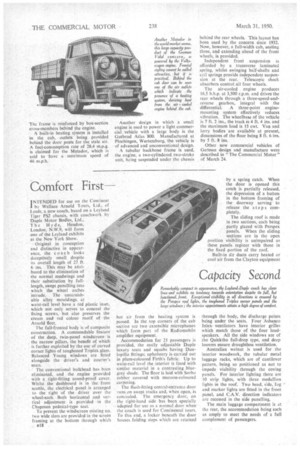New German Designs
Page 51

Page 52

If you've noticed an error in this article please click here to report it so we can fix it.
nEPART1NG from the layout which
has characterized this make since the late '20s, the latest product of the German Vidal concern is a four-wheeled commercial vehicle, powered by the Volkswagen engine. Full forward control is employed.
Previous models produced by the company, Vidal and Son, HamburgHarburg, have been three-wheeled light vehicles, known as the Tempo. The new model, the Matador, is of 1-ton capacity. Two body types are being built at present, a van with a body 8 ft. 6 ins, long, and a drop-sided lorry some 8 ins, longer.
The chassis is a triangular tubular structure with the base ahead of the front axle. Above the apex, at the rear, is welded a box-section, parallelogram'. cross-member, to which are affixed the coil springs for the rear independent suspension. Radius arms run from the wheels to the chassis side members and locate the wheels longitudinally.
Front suspension is independent. the driven being taken through the front wheels. A transverse semielliptic laminated spring is used at the front. The two tubular side members run parallel between the front wheels to the front-cross-members, and further reinforcement of the front end is ensured by the platform floor of the cab.
Mounted behind the front wheels, the Volkswagen engine drives forward through an integral gearbox and differential. A flat faurtylindered air-cooled engine of 1,131 c.c., it produces approximateht-25 b,h.p. at 3,300 r.p.m.
The frame is reinforced by box-section cross-members behind the engine.
A built-in heating system is installed in the cab, outlets being provided behind the door posts for the stale air. A fuel-consumption rate of 28.4 m.p.g. is claimed for the Matador, which is said to have a maximum speed of 46 m.p.h.
Another design in which a small engine is used to power a light commercial vehicle with a large body is the Gutbrod Atlas -800. Manufactured at Plochingen, Wurtemburg, the Vehicle is of advanced and unconventional design.
A tubular backbone frame is used, the engine, a two-cylindered two-stroke unit, being suspended under the chassis behind the rear wheels. This layout has been used by the concern since 1932. Now, however, a full-width cab, seating three, and extending ahead of the front wheels, is provided.
Independent front suspension is afforded by a transverse laminated spring, whilst swinging half-shafts and coil springs provide independent suspension at the rear. Telescopic shock absorbers control all four wheels.
The air-cooled engine produces 16.5 b.h.p. at 3,500 r.p.m. and drives the rear wheels through a three-speed-andreverse gearbox, integral with the differential. A three-point enginemounting system effectively reduces vibration. The wheelbase of the vehicle is 7 ft. 2 ins., the track is 4 ft. 4 ins, and the maximum load is 15 cwt. Van and lorry bodies are available at present, dimensions of the floor being 8 ft. 6 ins. by 5 ft. 8 ins.
Other new commercial vehicles of Getman design and manufacture were described in "The Commercial Motor" of March 24.




























































































